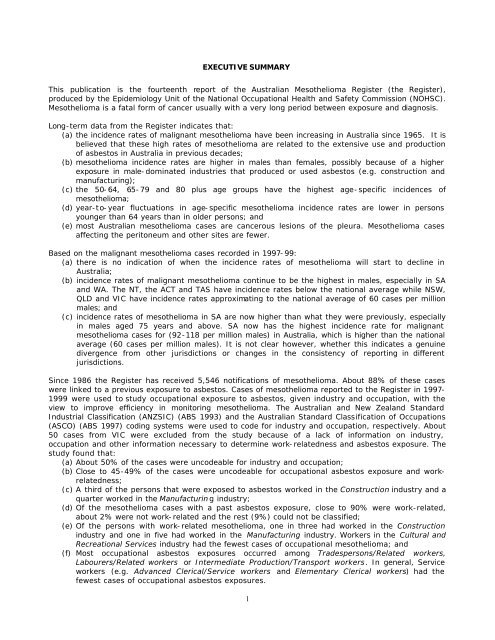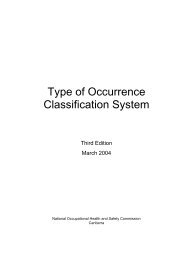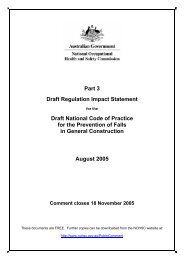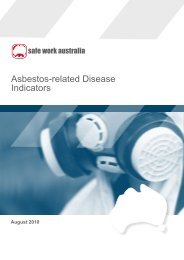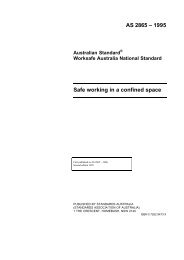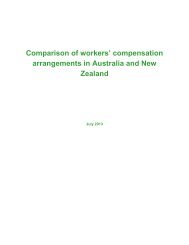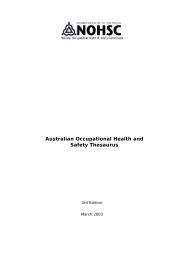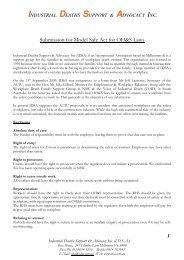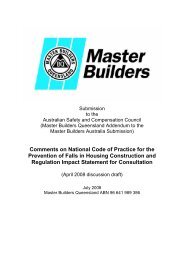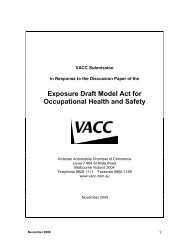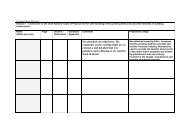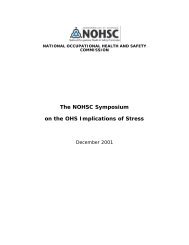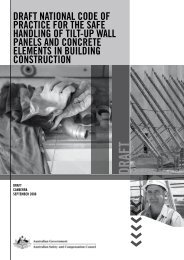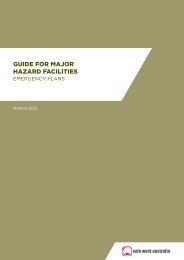Australian Mesothelioma Register Report 2002 - Safe Work Australia
Australian Mesothelioma Register Report 2002 - Safe Work Australia
Australian Mesothelioma Register Report 2002 - Safe Work Australia
Create successful ePaper yourself
Turn your PDF publications into a flip-book with our unique Google optimized e-Paper software.
EXECUTIVE SUMMARYThis publication is the fourteenth report of the <strong><strong>Australia</strong>n</strong> <strong>Mesothelioma</strong> <strong>Register</strong> (the <strong>Register</strong>),produced by the Epidemiology Unit of the National Occupational Health and <strong>Safe</strong>ty Commission (NOHSC).<strong>Mesothelioma</strong> is a fatal form of cancer usually with a very long period between exposure and diagnosis.Long-term data from the <strong>Register</strong> indicates that:(a) the incidence rates of malignant mesothelioma have been increasing in <strong>Australia</strong> since 1965. It isbelieved that these high rates of mesothelioma are related to the extensive use and productionof asbestos in <strong>Australia</strong> in previous decades;(b) mesothelioma incidence rates are higher in males than females, possibly because of a higherexposure in male-dominated industries that produced or used asbestos (e.g. construction andmanufacturing);(c) the 50-64, 65-79 and 80 plus age groups have the highest age-specific incidences ofmesothelioma;(d) year-to-year fluctuations in age-specific mesothelioma incidence rates are lower in personsyounger than 64 years than in older persons; and(e) most <strong><strong>Australia</strong>n</strong> mesothelioma cases are cancerous lesions of the pleura. <strong>Mesothelioma</strong> casesaffecting the peritoneum and other sites are fewer.Based on the malignant mesothelioma cases recorded in 1997-99:(a) there is no indication of when the incidence rates of mesothelioma will start to decline in<strong>Australia</strong>;(b) incidence rates of malignant mesothelioma continue to be the highest in males, especially in SAand WA. The NT, the ACT and TAS have incidence rates below the national average while NSW,QLD and VIC have incidence rates approximating to the national average of 60 cases per millionmales; and(c) incidence rates of mesothelioma in SA are now higher than what they were previously, especiallyin males aged 75 years and above. SA now has the highest incidence rate for malignantmesothelioma cases for (92-118 per million males) in <strong>Australia</strong>, which is higher than the nationalaverage (60 cases per million males). It is not clear however, whether this indicates a genuinedivergence from other jurisdictions or changes in the consistency of reporting in differentjurisdictions.Since 1986 the <strong>Register</strong> has received 5,546 notifications of mesothelioma. About 88% of these caseswere linked to a previous exposure to asbestos. Cases of mesothelioma reported to the <strong>Register</strong> in 1997-1999 were used to study occupational exposure to asbestos, given industry and occupation, with theview to improve efficiency in monitoring mesothelioma. The <strong><strong>Australia</strong>n</strong> and New Zealand StandardIndustrial Classification (ANZSIC) (ABS 1993) and the <strong><strong>Australia</strong>n</strong> Standard Classification of Occupations(ASCO) (ABS 1997) coding systems were used to code for industry and occupation, respectively. About50 cases from VIC were excluded from the study because of a lack of information on industry,occupation and other information necessary to determine work-relatedness and asbestos exposure. Thestudy found that:(a) About 50% of the cases were uncodeable for industry and occupation;(b) Close to 45-49% of the cases were uncodeable for occupational asbestos exposure and workrelatedness;(c) A third of the persons that were exposed to asbestos worked in the Construction industry and aquarter worked in the Manufacturing industry;(d) Of the mesothelioma cases with a past asbestos exposure, close to 90% were work-related,about 2% were not work-related and the rest (9%) could not be classified;(e) Of the persons with work-related mesothelioma, one in three had worked in the Constructionindustry and one in five had worked in the Manufacturing industry. <strong>Work</strong>ers in the Cultural andRecreational Services industry had the fewest cases of occupational mesothelioma; and(f) Most occupational asbestos exposures occurred among Tradespersons/Related workers,Labourers/Related workers or Intermediate Production/Transport workers. In general, Serviceworkers (e.g. Advanced Clerical/Service workers and Elementary Clerical workers) had thefewest cases of occupational asbestos exposures.1


